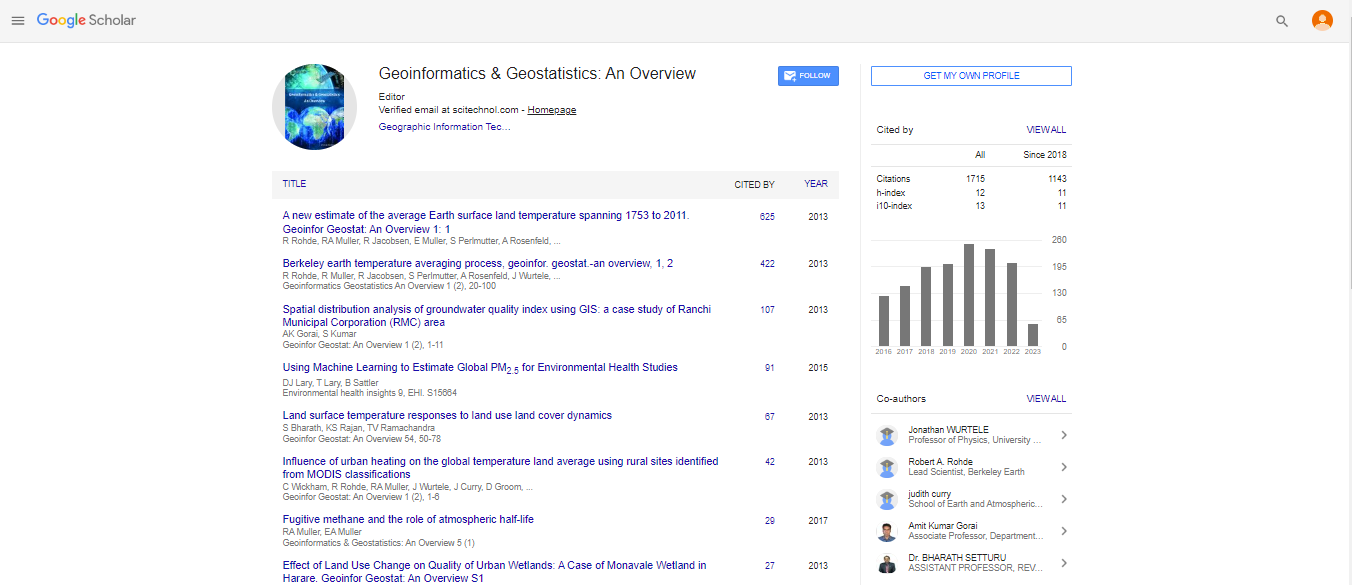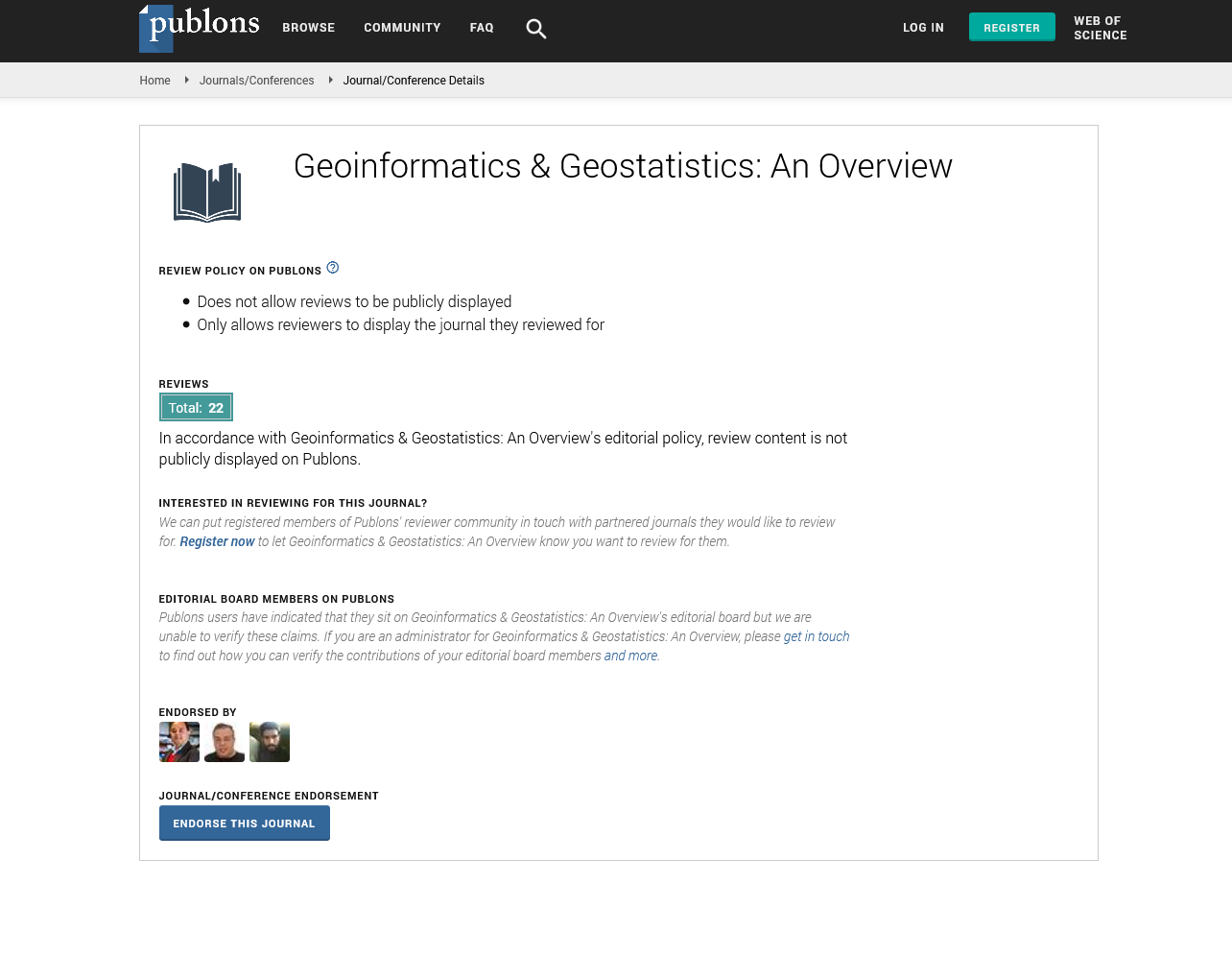Opinion Article, Geoinfor Geostat An Overview Vol: 12 Issue: 6
Analysing Interdisciplinary Applications of Spatial Data Analytics: Methods, Challenges and Opportunities
Michaela Windemuth*
1Department of Landscape Ecology and Landscape Planning, Justus Liebig University Giessen, Giessen, Germany
*Corresponding Author: Michaela Windemuth,
Department of Landscape Ecology
and Landscape Planning, Justus Liebig University Giessen, Giessen, Germany
E-mail: mwindem@uwelt.unigiessen.de
Received date: 27 November, 2024, Manuscript No. GIGS-24-143862;
Editor assigned date: 29 November, 2024, PreQC No. GIGS-24-143862 (PQ);
Reviewed date: 13 December, 2024, QC No. GIGS-24-143862;
Revised date: 20 December, 2024, Manuscript No. GIGS-24-143862 (R);
Published date: 30 December, 2024, DOI: 10.4172/2327-4581.1000424.
Citation: Windemuth M (2024) Analysing Interdisciplinary Applications of Spatial Data Analytics: Methods, Challenges and Opportunities. Geoinfor Geostat: An Overview 12:6.
Description
Spatial data analysis plays an important role in understanding geographic or spatial patterns by examining the distribution of data points across space. With the increasing availability of data from diverse sources such as satellite imagery, GPS systems field surveys, the importance of spatial data analysis in various fields like environmental sciences, urban planning epidemiology has grown significantly. Geographic Information Systems (GIS) and remote sensing technologies have revolutionized how spatial data is collected, analyzed applied, offering valuable vision into complex phenomena. Spatial data typically consists of geographic coordinates and associated attributes, which are important for analyzing patterns and relationships in data distributed across geographic locations. The integration of multiple data sources such as census data, satellite imagery field surveys helps create comprehensive spatial datasets that enhance decision-making and research outcomes.
The methods of spatial data analysis vary depending on the research objectives and the nature of the data. One of the most common approaches is Exploratory Spatial Data Analysis (ESDA), which involves visualizing spatial data using techniques like heatmaps, graphs cluster detection methods to reveal underlying patterns or anomalies in the data. Another key method is spatial interpolation, which predicts values at unsampled locations based on observed data from nearby points.
These models help in understanding how one spatial variable influences another, utilizing spatial lag and error models to capture spatial correlations. Additionally, geostatistics is an essential method for analyzing and modeling spatial variability. This includes the use of variograms and measures like Moran's I to assess spatial autocorrelation, which quantifies the degree of similarity between nearby data points. Another important aspect of spatial data analysis is network analysis, which focuses on studying spatial networks such as transportation systems or utility grids. This involves optimizing routes, evaluating connectivity determining the most efficient paths within a network.
Spatial data analysis has found widespread applications across a variety of domains. In environmental monitoring, it is used to track changes in ecosystems, such as deforestation, habitat destruction the depletion of natural resources. For example, satellite imagery has been instrumental in quantifying the extent of deforestation in the Amazon rainforest. In urban planning, spatial data analysis aids in land-use planning, optimizing infrastructure development managing traffic systems. It also plays a significant role in environmental studies, such as assessing urban heat islands.
By mapping the distribution of diseases, public health officials can better understand how diseases spread and target interventions more effectively. In agriculture, spatial data analysis supports precision farming techniques, such as analyzing soil quality, mapping crop yields monitoring weather patterns to optimize farming practices. Moreover, spatial data analysis is a key tool in disaster management, assisting in risk mapping, disaster preparedness emergency response strategies. For example, flood risk mapping and evacuation planning heavily rely on GIS and spatial data analysis.
Despite its growing significance, there are several challenges associated with spatial data analysis. One of the major challenges is the quality of the data, which can be inconsistent due to missing values, inaccurate measurements, or variations in spatial resolution. Another issue is the computational complexity of processing largescale spatial datasets, which often requires advanced algorithms and significant computing resources.
Moreover, integrating spatial data science with domain-specific knowledge is important for improving the relevance and applicability of spatial analysis in solving real-world problems. As the field continues to evolve, there is an increasing focus on integrating machine learning techniques with spatial data analysis, enabling the real-time processing of dynamic data and enhancing the ability to detect complex patterns and trends.
Conclusion
In conclusion, spatial data analysis plays a pivotal role in a wide range of disciplines, helping researchers and decision-makers make informed choices by understanding the spatial dimensions of problems. From environmental monitoring to urban planning and disaster management, spatial data analysis provides valuable insights that guide decision-making and policy formulation. As technological advancements continue, the integration of machine learning, real-time data processing collaborative platforms will further enhance the capabilities of spatial data analysis, making it even more transformative across diverse fields.
 Spanish
Spanish  Chinese
Chinese  Russian
Russian  German
German  French
French  Japanese
Japanese  Portuguese
Portuguese  Hindi
Hindi 
